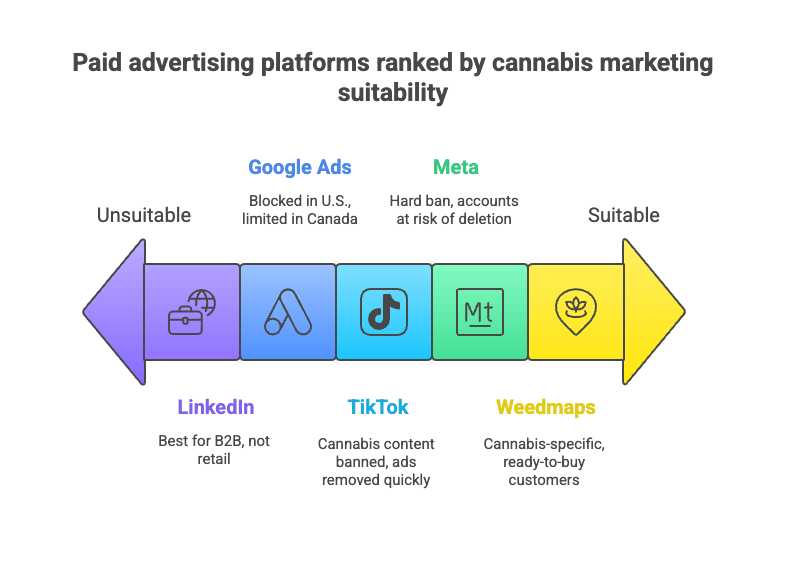
Paid Advertising for Cannabis Dispensaries: The Good, The Bad, and The Ugly
Running a dispensary today is a hustle. Demand is booming, competition is everywhere, and the rules around advertising feel like a trap. Paid ads can look like the shortcut to quick growth, but the reality is messy. Done right, they drive traffic, build brand authority, and get you in front of the right customers. Done wrong, they cost you money, kill your accounts, and lock you out of platforms you need.
This breakdown pulls back the curtain on how dispensaries are navigating the paid ad game, what platforms are really worth testing, and why knowing the risks is just as important as chasing the rewards.
The Allure of Paid Ads in Cannabis Marketing
Dispensaries are stacked shoulder to shoulder in markets like California, Colorado, and Ontario. Paid ads sell a dream of quick wins: targeted reach by zip code and age, polished campaigns that make your brand look bigger than life, and a shot at spiking traffic when you drop new products.
But here’s the truth. Behind that shine is a minefield of platform bans, sky-high costs, and a legal patchwork that can flip your investment into wasted spend overnight.
The U.S. vs. Canada Divide
United States
Federal law still blocks the game. Even if you’re running 100 percent legal in a state like Colorado or New York, platforms enforce federal restrictions. That means ads get flagged, accounts suspended, and money burned.
Canada
Federally legal but limited by the Cannabis Act. Ads can run if you strip them of lifestyle shots, youth appeal, and product glam. Campaigns look sterile, but at least the door is open. Platforms treat Canadian advertisers with more tolerance than their U.S. counterparts.
Local Spotlight
Vancouver
A retailer might run a Google Display ad to promote location details with compliance-heavy copy. No flashy bud pics, no bold taglines, but it gets adults to an age-gated site. Safe but dull.
Los Angeles
An L.A. dispensary fights to even get approved. Creative workarounds like promoting wellness blogs or events are common, but the second “cannabis” shows up, the ad dies. Many shops pivot to influencers or Weedmaps placements instead.
Platform Deep Dive

1. Meta (Facebook & Instagram)
The Good: Massive user base with advanced targeting. Visual formats allow storytelling.
The Bad: Hard ban on cannabis promotion. Accounts risk permanent deletion.
The Ugly: Even unpaid posts can get shadow-banned, crushing your organic reach.
2. TikTok
The Good: Explosive organic reach, especially with younger adults. Strong influencer culture.
The Bad: Cannabis content is banned. Ads get yanked within hours.
The Ugly: Even educational posts can vanish. Predictability is zero.
3. Google Ads
The Good: High-intent searches like “dispensary near me.” ROI-friendly analytics.
The Bad: U.S. dispensaries are blocked. Canada can run limited campaigns.
The Ugly: Appeals rarely work. Lose your Google Ads account and you lose more than ads.
4. LinkedIn
The Good: Works well for B2B cannabis services. Space for thought leadership.
The Bad: Direct dispensary ads get rejected. Targeting is weaker for consumers.
The Ugly: Not a fit for retail cannabis marketing.
5. Weedmaps
The Good: Cannabis-specific. Customers show up ready to buy. Menus and delivery integrated.
The Bad: Premium spots are expensive. Competing shops crowd the space.
The Ugly: Turn off spend and traffic falls off a cliff. No residual value.
Balancing Risk and Reward
Paid ads in cannabis are never “set it and forget it.” The risk is losing accounts and burning money before you see results. The reward is quick visibility when you find a gap that actually works.
Weedmaps is the safest bet, but it comes at a cost. On mainstream platforms, the real winners mix indirect ads with organic strategies like SEO, educational content, and email capture.
Recap and Action Steps
Paid ads for dispensaries are a gamble. Some bets can pay off, but most come with strings attached. Here’s what you should take away:
- U.S. dispensaries face harsher restrictions than Canadian ones.
- Meta, TikTok, and Google make running ads almost impossible without risking bans.
- Weedmaps is reliable but expensive and creates dependency.
- SEO and organic play a longer game that avoids shutdowns and builds lasting visibility.
Your move: Instead of going all-in on risky ad spend, focus on building a hybrid strategy. Test platforms carefully, lean into education and storytelling to bypass restrictions, and invest in SEO so your brand grows on solid ground. The dispensary that survives this maze isn’t the one with the flashiest ad. It’s the one with a marketing foundation that can’t be taken away overnight.
Related Articles
If you're enjoying our articles so far, here are more articles you can check out!



